From the Marxists Internet Archive...
John Maynard Keynes
The General Theory of Employment, Interest and Money
Chapter 12. The State of Long-Term Expectation
From Section VI:
The only radical cure for the crises of confidence which afflict the economic life of the modern world would be to allow the individual no choice between consuming his income and ordering the production of the specific capital-asset which, even though it be on precarious evidence, impresses him as the most promising investment available to him.
To consume, or spend on capital assets, with "no choice between". The only solution Keynes can see, for the problem he is considering, would be to disallow saving. To let the income-holder choose whether to spend on consumption or to spend on the production of future consumables, but not to allow money to be endlessly stashed away in savings.
Keynes continues:
It might be that, at times when he was more than usually assailed by doubts concerning the future, he would turn in his perplexity towards more consumption and less new investment. But that would avoid the disastrous, cumulative and far-reaching repercussions of its being open to him, when thus assailed by doubts, to spend his income neither on the one nor on the other.
Under such constraints the income-holder might prefer consumption, Keynes says, but that's not a problem. The problem, he says, is the failure to spend.
Why would Keynes say such a thing? I don't know; you'd have to ask him. But I know why I would say such a thing. This is the technologically current version of one of the graphs I was looking at back in the 1970s:
|
| Graph #1: The Non-Circulating Part of M2 Relative to the Circulating Part of M2 |
Savings increased rapidly before the Great Depression.
Savings fell rapidly during the Great Depression.
Savings resumed a path of increase in the midst of World War Two.
The turning points are highly significant.
The Great Depression was a disastrous and far-reaching repercussion of the excessive accumulation of savings.

Here's the Debt-per-Dollar graph, in red, added to the graph above:
|
Graph #2: The Non-Circulating Part of M2 Relative to the Circulating Part of M2 (blue)
and Total Public and Private Debt Relative to the Circulating Part of M2 (red) |
The two lines move together, with debt slightly lagged. Everything I have ever said about the Debt-per-Dollar graph applies equally to the "Savings per Circulating Dollar" graph. Interesting that the numbers on the right scale are just ten times the value of those on the left scale. (That wasn't my doing.)

The crisis economy is different. But in the normal economy, there is a certain window that money must stay in, for prices to remain stable. If money grows too fast or too slow it goes out of the window and prices get unstable. This is the reason nations have central banks, to keep money in the window.
You might say it differently. You might say central banks target interest rates, not the quantity of money. Well yeah, they say that, don't they. But the way they keep interest rates in the certain window is by buying and selling securities and such,
to adjust the quantity of money we call bank reserves.
That's what open market operations are.
In the normal economy there is a certain window that something must stay in, for prices to remain stable. Central banks keep this "something" in the window by making adjustments to the quantity of the kind of money that central banks issue.
So there is some stable relation between the Q of M and the size of GDP in the normal economy. What this relation is -- a stable ratio, for example, or a stable rate of change in the ratio -- is not yet clear.
Here's what I think, something like this. The concept is yet crude, so I need you to try to understand what I'm trying to say:
If M1/M2 is stable then a stable money/output ratio is probably what's needed.
But if M1/M2 is falling -- if circulating money is falling (and savings is increasing) relative to the total stock of money -- then a stable ratio won't do the trick. If the M1/M2 decline is stable, then a stable increase in the ratio might work. But if the M1/M2 is not stable, then all bets of stability are off.
Maybe M1 and M2 are out of date. I won't even argue the point. I'm just talking about circulating money and total (circulating plus uncirculating) money, and I'm using two-character shorthand. Feel free to pick better data for "circulating" and "total" money, and get back to me with a graph.
If the total quantity of money is kept in a window, but the circulating portion of it is declining as part of the total, then the quantity of money
needed available for transactions is declining relative to GDP. That's a problem.
Maybe it's not a problem for the people with most of the savings. But it's a problem for everybody else, and it's a problem for the economy. That's why the first turning point on Graph #1 comes just as the Great Depression begins. Too much money in savings, and not enough money circulating to sustain the transactions needed for GDP growth.

If there is any chance that I am right in saying that excessive savings is the problem, any chance that Keynes and I and a handful of others since the dawn of civilization are right about this, then I can tell you why civilizations die by suicide. Civilizations die by suicide because excessive savings is a problem, and most people refuse to accept the fact. Most people refuse even to consider the possibility.

Graphs and data can be visited at my
Savings and DPD Google Drive spreadsheet.
Related Post:
The Desire to Save





.png)



























